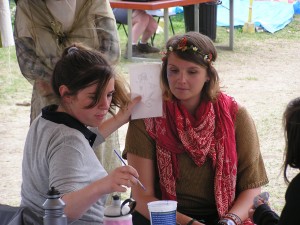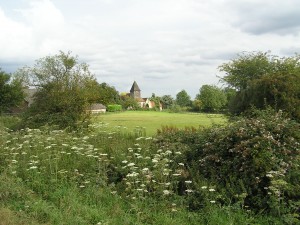The second ‘open day’ at Roman Silchester on Saturday (6 August) was as festive as the previous one. It was attended by many hundreds of visitors of all ages. Most were locals, but others had travelled great distances, including a couple from Northamptonshire, such is the fame of the event.
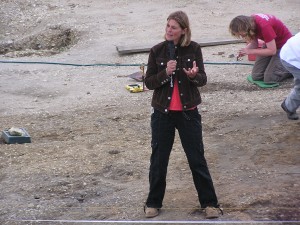 Professor Michael Fulford and Amanda Clarke took turns to deliver hour-long guided tours. Deftly brandishing her microphone as if she were presenting X-Factor, Amanda brought us up to date with the latest discoveries. We were encouraged to look upon the dusty contours of the site with ‘archaeologists eyes’. She pointed to the remains of the first-century roadway that cut across a corner of Insula IX. Its orientation, apparently based on the rising and setting of the sun, would have been irksome to the Romans, who later imposed their preferred grid system on the town.
Professor Michael Fulford and Amanda Clarke took turns to deliver hour-long guided tours. Deftly brandishing her microphone as if she were presenting X-Factor, Amanda brought us up to date with the latest discoveries. We were encouraged to look upon the dusty contours of the site with ‘archaeologists eyes’. She pointed to the remains of the first-century roadway that cut across a corner of Insula IX. Its orientation, apparently based on the rising and setting of the sun, would have been irksome to the Romans, who later imposed their preferred grid system on the town.
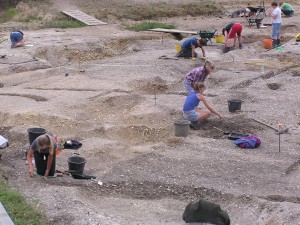 The early road was flanked on one side by a wooden palisade, with a ditch beyond it. On the other side, there were rubbish dumps and ‘natural geology’, as if it were on the very edge of town. One of the houses on this street was of high status (though wooden), and the owners had buried their little dog, perhaps a terrier, near one of the corners of the building. These people are said to have eaten fancy food off imported tableware.
The early road was flanked on one side by a wooden palisade, with a ditch beyond it. On the other side, there were rubbish dumps and ‘natural geology’, as if it were on the very edge of town. One of the houses on this street was of high status (though wooden), and the owners had buried their little dog, perhaps a terrier, near one of the corners of the building. These people are said to have eaten fancy food off imported tableware.
A still more arresting discovery has been that of a latrine on the opposite side of the road, which will tell us all about their diet. This latrine is narrow enough to have been equipped with a wooden seat – all of which leads Amanda to believe that the indigenous population were far from being the ‘grunting savages’ of legend. (She admits that the expression ‘beautiful latrine’ is unlikely to be uttered by anyone other than an archaeologist.) Presumably, though, the urban population of Silchester were not typical of Britain as a whole. In any case, were not the Atrebates tribe themselves recent immigrants from the Continent?
On the subject of the ubiquitous latrines, they have discovered that a later well was carelessly sunk over the remains of one. Poisoned water from such ill-positioned wells may explain the abandonment of the city in the fifth century. Amanda will have the winter months in which to ponder the significance of such data.
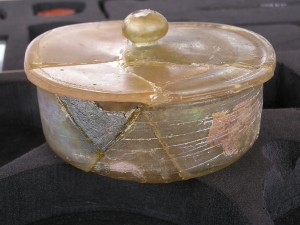 On the Reading Museum stall, visitors were invited to handle some of the fruits of the Victorian and Edwardian excavations, of which they are the custodians. These included a delicate needle, looking as good as new, and a hair-pin from one of the Museum’s loans boxes, which are available for hire by schools and other organisations. The choicest artefacts on display were perhaps this glass jar – almost mother-of-pearl in its opacity – which was an import from the region of Haifa; and this unexplained round tile inscribed with the tiler’s stamp –
On the Reading Museum stall, visitors were invited to handle some of the fruits of the Victorian and Edwardian excavations, of which they are the custodians. These included a delicate needle, looking as good as new, and a hair-pin from one of the Museum’s loans boxes, which are available for hire by schools and other organisations. The choicest artefacts on display were perhaps this glass jar – almost mother-of-pearl in its opacity – which was an import from the region of Haifa; and this unexplained round tile inscribed with the tiler’s stamp – 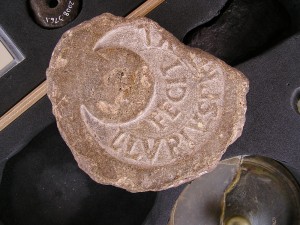 LLVRIVSPRO-VL FECIT (Lucius Lurius Pro[c]ul[us] made this).
LLVRIVSPRO-VL FECIT (Lucius Lurius Pro[c]ul[us] made this).
The bronze eagle on which Rosemary Sutcliff based her novel, The Eagle of the Ninth – recently filmed as The Eagle – is on permanent display in the Museum’s Silchester Gallery, along with further curious examples of the tiler’s art.
